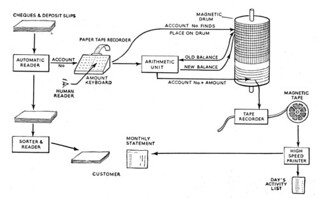Ledgers and Innovation in Banking
From 15MB:
I was flicking through the New Scientist
magazine from 29th November 1956 when I came across a very interesting
article on the digitisation of banking, a subject of great current
interest. The article has a very useful diagram for those of us who
wonder how exactly it is that banks manage customers’ accounts using computers.

I don’t know which bank this is, probably TSB, but in any case it is
what the article says about digitisation that I found interesting.
Apparently, it’s all to do with something called “ledger management”.
The article gives a helpful example, explaining how “when a bank clerk
first accepts a cheque, he prints on it with something like a typewriter
a note of the amount in magnetic ink, all subsequent
operations—sorting, listing and entering in ledgers—can be done without
human assistance”.
Reading further on, I discovered that you can have different kinds of
ledgers that work in different ways. The author notes that this is only
one way of “ledgering automatically” and that the “choice of a system
depends on how far was is prepared to go: whether automatic book-keeping
is to be done only at head office, whether in this case the accounting
for all the branches, or whether branches will have their own equipment
or to be grouped around sub-centres”. The same centralisation versus decentralisation of ledgers argument continues to this day.
The article continues by noting that banks do not seem to be making
as much of this interesting new technology as they might and that “what
may prove to be more serious is the determination to cling to time-honoured procedures”. Well, yes indeed. This is just what Anthony Jenkins meant when he said that banks had yet to be disrupted by new technology
(shortly before he was fired as Barclays CEO). And if you think those
“time-honoured procedures” are fading, you’re dead wrong, since 95
percent of ATM transactions still pass through COBOL programs, 80
percent of in-person transactions rely on them, and over 40 percent of
banks still use COBOL as the foundation of their systems.
There’s no point using blockchain, or any other shared ledger
technology, to implement these existing processes. The way forward, in
banking at least, is to use the new technology to implement new ways of
doing businesses. There’s a good argument for thinking that the central
co-ordination mechanism for these new ways of doing business might well
be trust. Speaking at Davos, way back in 2015, Marc Benioff (the CEO of Salesforce) said that “Trust
is a serious problem, we have to get to a new level of transparency –
only through radical transparency will we get to radical new levels of
trust.”
I could not agree more. I think he is absolutely spot on. This is why
I have been focusing on the use of new technologies (and specifically biometrics, blockchains and bots)
to create a different kind of financial services infrastructure. I
spoke about this earlier in the year and the Digital Jersey Annual
Review [YouTube, 24 minutes] and have pushed a similar message out to a number of different audiences since then....MORE
